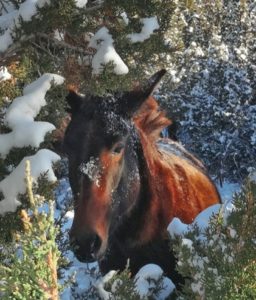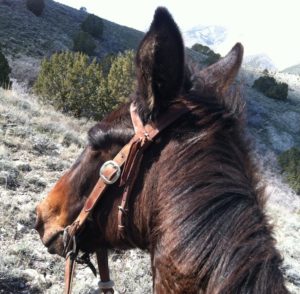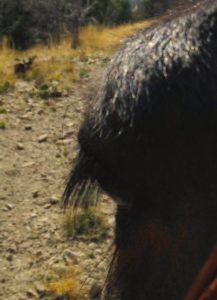 Our recent NickerNews and BestHorsePractices survey brought to light some readers anxious for more mule news! Research and practice-specific posts will come, but here are a few anecdotal tidbits:
Our recent NickerNews and BestHorsePractices survey brought to light some readers anxious for more mule news! Research and practice-specific posts will come, but here are a few anecdotal tidbits:
Jolene is the December cover girl for the Save Your Ass Long Eared Rescue 2015 Calendar. Yahoo! You can order soon to help this non-profit, a New Hampshire charity that’s saved hundreds of mules and donkeys since its founding in 2007.
The pretty molly mule has improved on the trail, but saddling up remains our nagging shortfall. To remedy this, we recently devoted three, hour-long sessions entirely to saddling and pre-ride procedures:
- I used a 20-foot line and looped it around a rail a few times instead of tying her fast and hard. That meant she could move around and deal with the saddle and saddle pad on her own terms. Gradually, she became more and more willing to stay close and stay still.
- I offered her hay so she could graze and relax at all times during the saddling.
- The saddle came off and went back on, got cinched up, uncinched, came off and went back on. (With a 30-pound saddle, my arms got stronger in the process.)
- Lots of rubs and pauses when she was relaxed and in the right place.
 The tacking up process improves. It used to be an hour-long deal. Then it took 30 minutes. Now, we can head out after 15 minutes of cool-headed prep. Read about more holes in the training here.
The tacking up process improves. It used to be an hour-long deal. Then it took 30 minutes. Now, we can head out after 15 minutes of cool-headed prep. Read about more holes in the training here.
Here are a few odd mule tidbits I’ve learned:
- Many mules can be very sensitive about their ears. But if you can get your finger inside an ear, right where it meets the poll, you might find a super-sensitive pleasure zone. When I rub Jolene here, she stretches her head and flutters her eyes.
- Mules don’t smell. That is, they don’t smell like horses and they don’t seem to emit any distinctive odor (unless they’ve rolled in something or are sweaty from a hard ride).
- Of everyone in the herd, Jolene complains least about the rocky, irregular footing. Her hooves are tougher. And it seems, so is her stomach. She is largely responsible for eating the less palatable forage, like scrub oak, in the pasture. These hardiness observations seemed to be confirmed by the Baja vaqueros, who’ll be feted at the National Cowboy Poetry Gathering, and who use mostly mules in their ranch work.
- Mule eyelashes curve down towards the eye more than horse’s eyelashes. That this makes them more endearing is strictly subjective.
